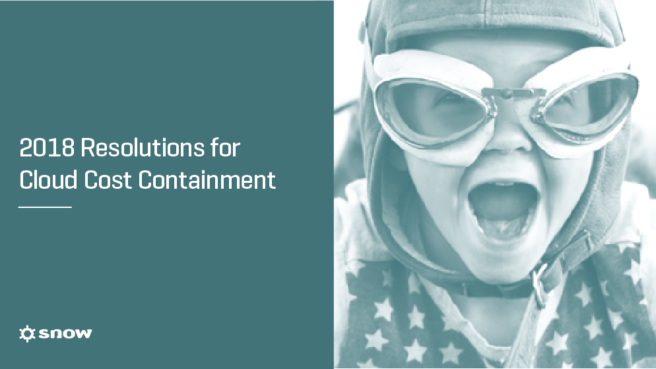2018 resolutions for cloud cost containment

It will come as little surprise that rapid cloud adoption is predicted to continue in 2018. In fact, IDC predicts that by 2020, data centers will account for just half of the market, with public cloud making up just under a third and private cloud capturing 20 per cent .
But alongside the massive potential for flexibility and scalability that the cloud holds, there is substantial risk for overspending. And of all the services – including SaaS, PaaS, IaaS and a host of other as-a-Service offerings – it is IaaS that presents the greatest financial risk, with RightScale estimating that 30 per cent of cloud computing budget is being wasted
To ensure the CIO and CFO don’t spend the year tackling massive, unexpected bills for their cloud usage, here are three recommendations to help contain cloud costs.
Visibility
A key part of the CIO’s role is to keep to budget, as well as accurately plan for the future. This is only possible with a comprehensive understanding of both current and past cloud consumption – without it, the IT office will find itself facing cost spikes and unplanned expenditure.
To effectively manage cloud expenditure, CIOs must understand: what services have been purchased; which are in use; does the usage match the business’s needs; and, if it can’t be decommissioned, who in the business should foot the bill?
With business units increasingly bypassing the IT office, going direct for the services they want rather than waiting for the IT team to provide it, capturing this information is no mean feat. Especially as the bill from the provider typically only gives a list of environments and costs, not who set up the virtual machine (VM) and whether it’s still in use.
Tagging will be a crucial to CIOs achieving the visibility they need in 2018 for effective cloud management; enabling the IT office to identify who spun up any VM, what it’s being used for, and how long they expect to use it for.
Automation
Automation will play an important role in enabling CIOs to get a handle on their IaaS environments, through intelligent self-service. By setting up a self-service store, for instance, the IT office enables business units to request the service that they need for only as long as they need them – providing the on-demand service business units crave, while enabling the IT to manage and optimize assets.
The service can also support the IT team by automating the routine for environment takedown. Enabling users to choose how long they need each VM for, the automated system can let them know when they’re coming close to the deadline, prompting the user to either take down or extend its usage. This model also supports tagging, providing the aforementioned essential information without adding further cumbersome, manual processes to the IT team.
Combined, this automated approach not only helps CIOs send bills to the right department, but reduces resources wastage and unnecessary expenditure by promoting a more responsible approach to spinning down unused VMs.
Accountability
It has never been easier or more interesting for business units to spin up VMs – whether it’s developers creating test environments; pre-sales showcasing demos; or customer support using one to replicate a customer’s environment to see if they can work out how to solve an issue.
But, while enabling business units to become more agile, the decentralized approach to purchasing IaaS assets has made it much harder for the IT team to track and manage usage – and, ultimately cost.
With IaaS now costing by the second, when unused VMs are left running it bleeds cloud budget. However, as long as the bill for these machines doesn’t fall to the business unit that spun it up, the lack of accountability results in a lacklustre approach.
CIOs must accept that they have lost control of cloud purchasing. But to ensure they don’t lose control of their cloud budgets, it is crucial that they ensure that the right bills go to the right business units. Only by driving greater accountability for more responsible consumption of cloud resources can the CIO ensure that cloud spending doesn’t spiral out of control. And undoubtedly, we will start to see that once business unit leaders start footing the cost of those bills.
Build a strategy that works for 2018
As IaaS adoption and usage across the business increases, it’s essential that the IT office evolves from the traditional methods of managing and optimising their assets to reflect new purchasing trends.
By introducing visibility, automation and accountability as core pillars to their 2018 strategy, CIOs have the potential to create a governance-based model that will allows for the agility that business units require in consuming IaaS, while still maintaining their responsibility for effective allocation of technology spend.